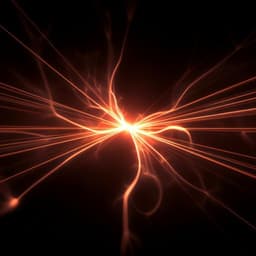
Food Science and Technology
Ultrafast cold-brewing of coffee by picosecond-pulsed laser extraction
A. R. Ziefuß, T. Hupfeld, et al.
Experience coffee like never before with our revolutionary method for cold-brewing, utilizing ultrashort-pulsed lasers to extract flavors in mere minutes! This exciting research was conducted by Anna R. Ziefuß, Tim Hupfeld, Sven W. Meckelmann, Martin Meyer, Oliver J. Schmitz, Wiebke Kaziur-Cegla, Lucie K. Tintrop, Torsten C. Schmidt, Bilal Gökce, and Stephan Barcikowski.
~3 min • Beginner • English
Introduction
Global coffee consumption is rising, and cold-brew coffee has surged in popularity due to perceived lower acidity and bitterness and associated health and lifestyle appeal. However, conventional cold brewing requires long extraction times (hours to days), limiting flexibility, spontaneous consumption, and slowing product development. Increasing surface area by finer grinding is limited by filter clogging. The study asks whether ultrashort-pulsed laser post-processing (LPP), a technique from laser synthesis and processing of colloids (LSPC), can rapidly extract coffee constituents at room temperature, achieving a cold-brew-like composition in minutes without thermal degradation. The purpose is to demonstrate an ultrafast, room-temperature extraction method that preserves cold-brew characteristics while dramatically shortening brew time, and to compare its chemical profile with traditional hot and cold brews.
Literature Review
Coffee composition depends strongly on brewing method, with cold brewing reported to yield lower acidity and bitterness and distinct flavor profiles. Despite automation efforts, conventional cold-brew times remain around 12 hours. LSPC and LPP are established for inorganic colloids and have been extended to some organic solids, including drug nanonization and bioactive compounds, where ultrashort pulses minimize thermal effects and contamination due to contact-free processing. Prior studies indicate femto- to picosecond pulses can fragment particles with minimal degradation (<2%) due to limited heat propagation, while nanosecond pulses can induce more thermal effects. Reports on LPP of organic food matrices are limited, motivating exploration of ultrashort laser extraction for coffee to combine cold-brew benefits with speed.
Methodology
Materials: Commercially roasted and ground 100% Arabica beans (Coffee Pirates, Costa Rica SHB EP Tarrazú), used 10 days post-roast. Water: ultrapure/deionized. Filters: commercial paper coffee filters (Kaufland TIP, size 4) used in all variants for comparability.
Laser extraction (ps-LPP): 1.65 g coffee powder dispersed in 30 mL ultrapure water in a stirred vessel. Irradiation with an Nd:YAG laser at 532 nm (EdgeWave), 10 ps pulse duration, 80 kHz repetition rate, 125 µJ pulse energy; processing time 3 min. Temperature rise measured at 5 ± 3 °C (near room temperature). After irradiation, suspension was filtered with the same coffee filters.
Comparative brewing protocols: Hot brew: 10 g coffee in a filter; 100 mL water at 90 °C poured over; permeate collected. Cold brew: 10 g coffee in 181 mL water at room temperature for 24 h; then filtered. Process parameters summarized: Hot (10% w/v, 90 °C, 3 min contact), Cold (5.5% w/v, ~21 °C, 1440 min), ps-Laser (5.5% w/v, 26.0 ± 3.0 °C, 3 min; 10 ps, 80 kHz, 532 nm, 125 µJ).
pH measurement: Conducted immediately after filtration (21.5 °C). Statistical analysis: Single-factor ANOVA used to compare pH among variants.
Caffeine quantification: Caffeine extracted from aqueous coffee with 10 mL chloroform; impurities removed by two re-extractions with 2 M KOH; chloroform evaporated. Caffeine quantified gravimetrically and optically. UV–Vis spectra recorded (Thermo Scientific Evolution 201); caffeine quantified via absorbance at 273 nm using pre-calibration from milled caffeine tablets (Coffeinum N) dissolved in water; supernatant after centrifugation (2415 g, 2 min) used for calibration. Caffeine release efficiencies were normalized to coffee powder concentration, temperature, process duration, and combinations thereof.
Non-target LC–HRMS (liquid phase): Agilent 1260 Infinity II LC with Zorbax Bonus RP RRHD column (50 × 2.1 mm, 1.8 µm) at 30 °C. Mobile phases: A (5% MeOH in water, v/v) and B (MeOH), both with 0.1% formic acid and 5 mM ammonium formate. Gradient: 0% B to 95% B in 10 min, hold 2 min, re-equilibrate 3 min; flow 0.4 mL/min; injection 5 µL. MS: Q Exactive Plus Orbitrap in positive/negative modes; HESI source (sheath 37 au, aux 15 au, sweep 2 au), probe heater 350 °C, capillary 320 °C, spray 3500 V, S-Lens RF 65% (pos) and 80% (neg). DDA MS/MS on top 10 ions; full scan resolution 70,000; MS/MS 17,500; m/z 100–1000; max IT 100 ms. Feature detection with Compound Discoverer: 5 ppm mass tolerance, S/N ≥3, min peak 5×10^5, RT shift ≤2 min; adducts considered: positive [M+H]+, [M+Na]+, [M+NH4]+, [M+H+NH4]+; negative [M−H]−, [M−H−H2O]−, [M−2H]2−. Compound grouping: 5 ppm, RT tolerance <0.2 min; preferred ions [M+H]+, [M−H]−. Database matching via mzCloud and ChemSpider (Aurora Feinchemie, NIST), refined with mzLogic (min score 30).
Headspace (semi-)volatiles by ITEX-DHS GC–MS: Samples incubated at 50 °C for 15 min, shaken 1500 rpm; ITEX Type SilicoNert 2000 Tenax TA (80/100 mesh G23); 55 × 1000 µL extraction strokes at 100 µL/s; final 1000 µL headspace drawn and thermally desorbed (ITEX syringe 300 °C) into GC injector (250 °C), injecting 500 µL; syringe cleaned at 340 °C (13 min pre, 15 min post). GC–MS: Shimadzu GCMS-TQ-2010, full scan m/z 40–400 (0.05 s/event), ZB-FFAP column (50 m × 0.32 mm × 0.5 µm), He carrier. Oven: 35 °C 5 min; 5 °C/min to 110 °C (hold 2 min); 10 °C/min to 240 °C (hold 6 min); 10 °C/min to 250 °C (hold 8 min). Injector, transfer line, EI source at 250 °C; splitless with 5 min sampling and solvent cut. Identification via NIST EI 70 eV library.
Replicates and data: Three replicates per variant for statistics (error bars as SD). Data available upon reasonable request.
Key Findings
- Picosecond laser extraction (3 min) at room temperature produced coffee with caffeine concentration ~25 mg/100 mL (reported up to ~30 mg/100 mL on average), comparable to traditional hot-brew outcomes, without significant heating (temperature rise 5 ± 3 °C).
- pH: Laser-brewed coffee exhibited pH comparable to conventional cold brew and slightly less acidic than hot brew; ANOVA including hot brew showed significant differences (F(3,39)=4.813, p<0.03), indicating hot-brewed coffee is more acidic.
- Caffeine extraction efficiency: When normalized per minute of extraction time, cold brew is two orders of magnitude less efficient than both hot and laser methods. Time-normalized caffeine extraction was ~300× higher for ps-laser vs cold brew and about 3× higher than hot brew. When normalized to powder concentration, temperature, and time combined, ps-LPP showed the highest relative release (3–5× higher than cold brew) and comparable to hot brew.
- LC–MS (liquid phase): No unique or unknown compounds were detected in laser-extracted coffee versus conventional methods in the 100–700 g/mol range, suggesting minimal degradation with ultrashort pulses. The main differences among variants were relative levels of caffeine and trigonelline: cold brew highest in trigonelline, hot brew lowest; ps-laser intermediate. The caffeine:trigonelline ratio was similar for cold brew and ps-laser (~1:0.9). Approximately 700 other substances were detected; chlorogenic acid was more pronounced in cold variants; kahweol detected in all, increased in cold brew.
- Headspace (semi-)volatiles: Many volatiles common to hot and cold variants were observed. Pyridine, associated with smoky flavor and formed from trigonelline during roasting, was detected only in cold variants (conventional cold brew and ps-laser), indicating better preservation of certain semivolatiles without heating.
- Overall, the chemical profiles (liquid and headspace) of ps-laser coffee closely matched conventional cold brew while achieving far faster extraction.
Discussion
The study demonstrates that ultrashort (picosecond) laser post-processing can rapidly extract coffee solubles at near-room temperature, achieving a chemical profile akin to conventional cold brew in minutes. The minimal bulk heating and ultrafast energy deposition limit thermal degradation and preserve semivolatiles such as pyridine, aligning the headspace composition with cold brew and contrasting with hot brew. Despite similar or slightly lower absolute caffeine amounts than cold brew under the tested ratios, the laser method dramatically outperforms both cold and hot brewing in time-normalized caffeine extraction efficiency. pH comparisons place laser-brew within the cold-brew range and less acidic than hot brew, which may influence perceived bitterness. LC–MS profiles show no laser-specific degradation products, supporting the suitability of ultrashort pulses for organic matrices. These findings address the initial challenge of reducing cold-brew time without sacrificing compositional attributes, suggesting laser extraction as a promising, efficient, and controllable brewing modality.
Conclusion
Ultrashort-pulsed laser extraction enables ultrafast, room-temperature coffee brewing, reducing typical cold-brew times from ~12 h to 3 min while achieving caffeine concentrations (~25–30 mg/100 mL) and chemical profiles comparable to conventional cold brew. Time-normalized caffeine extraction is ~300× higher than cold brew and ~3× higher than hot brew. LC–MS and headspace analyses indicate that laser-brewed coffee preserves alkaloids and semivolatiles without introducing unique compounds, consistent with minimal thermal degradation. Future work should optimize laser parameters, explore continuous processing (e.g., liquid jet reactors) for scalability, perform comprehensive quantitative analyses to meet food regulations, and conduct controlled sensory/olfactory studies to validate consumer-perceived attributes.
Limitations
- Quantitative LC–MS analysis was non-targeted and standard-free; absolute concentrations beyond caffeine were not determined, limiting precise quantification and comparisons.
- Possible dilution and differing powder-to-water ratios complicate direct comparisons with hot brew; some observed differences (e.g., lower alkaloids in hot brew) may be influenced by extraction conditions.
- Sensory evaluation (taste and aroma) was not performed; perceived bitterness and flavor implications were inferred from chemical proxies and literature.
- Pyridine detection differences between hot and cold variants were hypothesized (evaporation vs. pH/ionization effects) but not experimentally validated.
- Paper filters may contribute leachates; although used consistently across variants, this could introduce minor artifacts.
- Small sample size (n=3 per variant) limits statistical power for some metrics.
Related Publications
Explore these studies to deepen your understanding of the subject.







